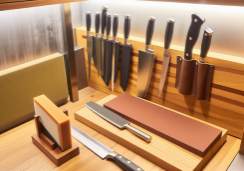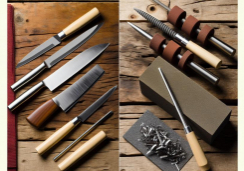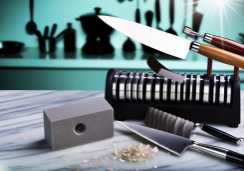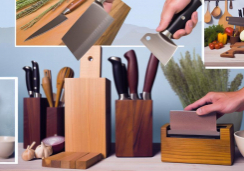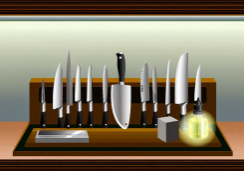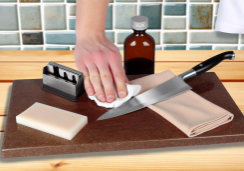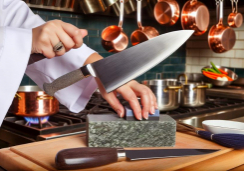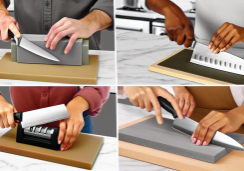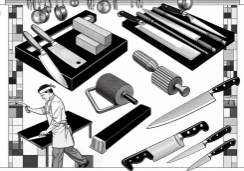What Are Top Knife Sharpening Methods for Chefs?
In the culinary world, your knife is sharper than Occam's razor, slicing through ingredients with the precision of a surgeon's scalpel—if, that is, you've mastered the art of knife sharpening.
As a chef, you're well aware that a dull knife is a cardinal sin in the kitchen, threatening not only the integrity of your dishes but also your fingers. You've likely encountered a myriad of methods promising to keep your blades in top condition, from the traditional whetstone that requires a steady hand and an eye for angles, to the convenience of an electric sharpener that works with the push of a button.
Honing with a steel rod might be your daily ritual, yet you might wonder if stropping could elevate your knives to a level of sharpness only told in hushed tones among culinary professionals. Each technique has its advocates and its nuances, and finding the one that best suits your style and needs could change the way you command your kitchen.
Stay with me, and let's explore what separates the best from the rest, ensuring your knives are always ready for their next culinary challenge.
Understanding Knife Edges
Every chef must recognize that the edge of a knife isn't just a simple blade; rather, it's a sophisticated tool requiring precise maintenance to ensure optimal performance. Your understanding of different edge types and their specific applications enhances your culinary precision and efficiency.
There are various edge styles, including straight, serrated, and hollow grinds, each serving distinct purposes.
Straight edges deliver clean cuts and are ideal for slicing vegetables and finely chopping herbs. You'll find daily tasks easier with a well-maintained straight edge, which generally requires regular honing and periodic sharpening to maintain its keenness.
Serrated edges, with their saw-like appearance, are perfect for cutting through crusty bread or tough-skinned fruits without damaging the delicate interior. These edges tend to remain sharp longer but can be more challenging to restore once they dull.
Hollow ground blades feature concave sides leading to a fine edge, offering a level of sharpness suitable for precise cuts in delicate tasks. However, they can be more fragile and may require a gentler touch when sharpening.
Whetstone Sharpening Technique
Understanding the various edge types equips you with the knowledge necessary to master the whetstone sharpening technique, a skill that's essential for maintaining the razor-sharp edge of your straight and hollow ground knives. Whetstone sharpening is a process that involves a series of steps to ensure the optimal edge.
Firstly, you'll need to select the appropriate grit size of your whetstone. Coarse grits are ideal for repairing damaged edges, while finer grits are used for honing and polishing. Soak your stone in water for the recommended time before you begin to provide the necessary lubrication.
Once your stone is ready, hold the knife at the correct angle against the stone's surface—typically a 20-degree angle for chef's knives. Use even, controlled strokes while maintaining consistent pressure and angle. Sweep the blade across the stone, working from the heel to the tip. Alternate sides regularly to sharpen both sides of the blade evenly.
Remember to regularly check the burr formation, a sign that you're sharpening effectively. After achieving a sharp edge with the coarse grit, progress to a finer grit stone to refine and polish the edge. Rinse your knife and wipe it dry to remove any residue.
With practice, you'll enhance your proficiency in this time-honored technique, ensuring your knives are always in top condition.
Honing With a Steel Rod
After your knife has been sharpened on a whetstone, it's crucial to maintain the edge with regular honing, which is where a steel rod becomes an essential tool in your kit. Unlike sharpening, which grinds away metal to produce a new edge, honing realigns the existing edge of the blade. This process corrects the microscopic bends and nicks that occur with normal use, keeping your knife's edge straight and effective.
To properly hone your knife, hold the steel rod vertically with the tip secured on a non-slip surface. Place the heel of the knife against the top of the rod at approximately a 15 to 20-degree angle. Apply light pressure and slide the blade down the rod, pulling it towards you while simultaneously gliding it from the heel to the tip. Repeat this motion several times on one side, then switch to the other side of the blade, ensuring equal treatment for both sides.
With consistent use, a steel rod will maintain the sharpness of your knife, reducing the frequency of whetstone sharpening sessions. It's a quick, effective method that every chef should master to ensure their tools are always in peak condition for precise cuts.
Electric Sharpener Efficiency
While honing with a steel rod is essential for maintaining a knife's edge, electric sharpeners offer a quick and efficient alternative for chefs needing to restore a dull blade. Unlike manual sharpening methods that require skill and experience to achieve the correct angle and pressure, electric sharpeners remove the guesswork. They often feature preset angles, ensuring a consistent edge every time.
You'll find that electric sharpeners can save you significant time, especially during busy periods in a professional kitchen. With abrasive wheels or belts that spin at high speeds, these devices can reshape and refine a knife's edge with minimal effort from you. Simply running the blade through the sharpener's designated slots a few times can transform a blunt knife into a razor-sharp tool.
However, it's crucial you choose a high-quality electric sharpener that won't overheat or remove excessive material from your knives. Look for models with adjustable settings that cater to different types of knives and bevel angles.
Stropping for Razor-Sharpness
To achieve the ultimate edge on your knives, incorporate stropping into your sharpening regimen, as it polishes the blade and aligns any micro-serrations for a truly razor-sharp finish. Stropping isn't just about getting a sharp edge; it's about maintaining that edge for as long as possible. It's a step often overlooked by novices, but for a chef requiring precision, it's essential.
Here's how you can master the art of stropping:
- Choose the right strop:
- Leather is the traditional material, ideal for its slight give and effectiveness.
- Synthetic options are also available, which can offer a more uniform surface.
- Apply the right technique:
- Hold the knife at the same angle as when sharpening, usually 15-20 degrees.
- Gently pull the knife towards you, edge trailing, across the strop's surface.
What Are the Best Knife Sharpening Methods for Home Use?
When it comes to home knife sharpening techniques, there are a few popular methods to consider. Using a sharpening stone or honing steel can help maintain a sharp edge. Electric knife sharpeners are another convenient option for quickly restoring blade sharpness. Whichever method you choose, regular maintenance is key.
Conclusion
You've explored various knife sharpening techniques, from whetstone mastery to honing with steel rods, electric sharpeners, and stropping. Each method has its merits, tailored to your skill level and the tools at hand.
Remember, maintaining a sharp edge is crucial for precision and safety in your culinary endeavors. Choose the technique that suits you best and keep your blades in top condition.
Your expertise and care in sharpening will reflect in the quality of every slice and dice.

